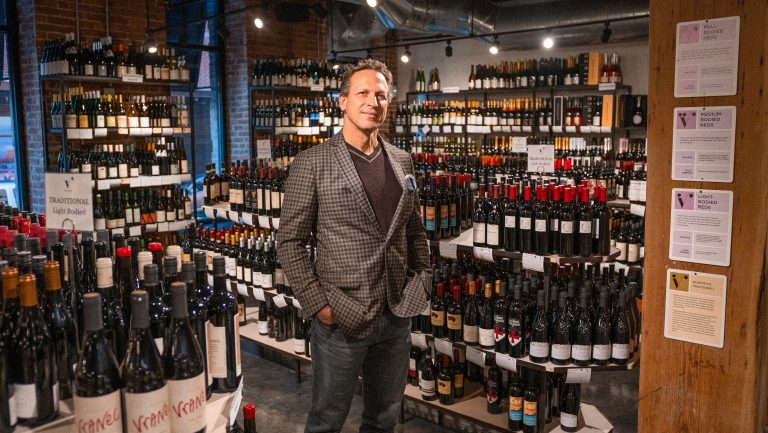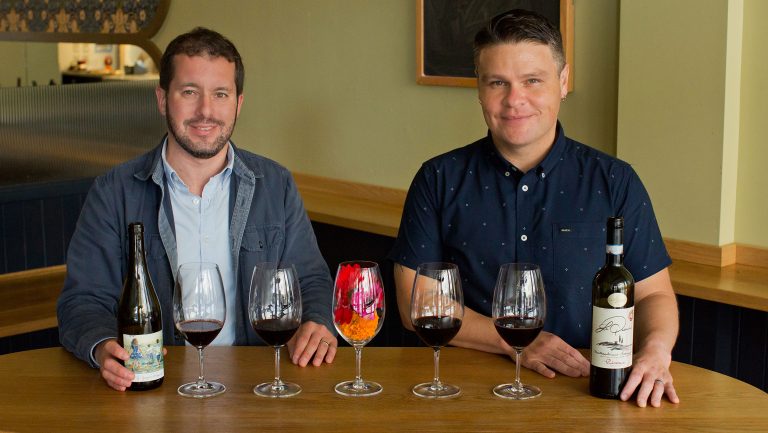New Jersey is brewing up its own unique beverage alcohol market, a mix between the influences of the adjacent big cities of New York and Philadelphia and its own burgeoning home-grown craft beverage industry.
These forces are blending to create an alcohol industry in this state of nearly 9 million people that is embracing new trends but at the same time trying to not upset the way things have been done for decades.
For example, independent mom-and-pop bars, restaurants, and liquor stores are protected by rules restricting big chains from overwhelming the state, as they’ve done in many other markets around the country. But having kept the big chains at bay for decades, some of those same independent businesses now cast a wary eye at the new craft breweries and distilleries that are opening across the street. This has prompted constant efforts in the state legislature to try to hammer out a way to keep the industry fair and balanced during changing times.

Don’t miss the latest drinks industry news and insights. Sign up for our award-winning newsletters and get insider intel, resources, and trends delivered to your inbox every week.
There are other dynamics at work as well. While the influence of the big cities has brought throngs of younger consumers to the north and south of New Jersey, especially places like Jersey City in the north, businesses in some other areas not only have felt lost in the mix but have had problems getting the products they need from distributors.
It’s hard to get lost for too long in New Jersey, however, which is ranked 47th in size among states but 37th when it comes to population. The densely packed nature of the state has caused many alcohol companies to find it a lucrative place to do business. As Gary Fisch, the founder and CEO of Gary’s Wine & Marketplace in Wayne, which operates four stores in the state, says, “We’re a very populated, upwardly mobile state. Our client base is phenomenally good.”
Michael Halfacre, the executive director of the Beer Wholesalers’ Association of New Jersey, adds that “there are over 1,500 package stores in the state; there are over 7,000 restaurants/bars/taverns in the state. For a very large population, but a very small geography, New Jersey’s alcohol marketplace is in balance. It’s vibrant, it’s fair, and it’s got a tremendous amount of variety.”
Craft Introduces a New Dynamic
As in most parts of the country, local artisanal beverages are making their mark on New Jersey. There are currently 114 breweries in the state and 19 brewpubs, according to the New Jersey Brewers Association (NJBA). Another 26 are said to be in the pipeline. The same goes for craft distilleries, which are experiencing a boom of their own, their number now reaching 24.
Says Eric Orlando, the executive director of the Brewers Guild of New Jersey, “There are a lot of towns, particularly Main Streets, that have seen better days [and] are looking for some type of anchor business to draw people downtown to some of the other ancillary businesses around it, the other restaurants. They like the vibe that a craft brewer brings into these smaller towns.”
Zack Ohebshalom, the cofounder of Asbury Park Distilling, says his distillery has brought something of the kind to downtown Asbury Park, a place that’s had its ups and downs over the years but has recently undergone a resurgence. “We had a very forward-thinking mayor and council in that we are the only craft distillery in the state of New Jersey that’s located in a commercial downtown area,” he says. “Every other craft distillery in the area is confined to industrially zoned property. So we’re right in the heart of downtown, surrounded by bars and restaurants.”
Some long-standing traditional bars and restaurants in other parts of the state have mixed feelings about the phenomenon, however. Jim Fris, the CEO of the PJW Restaurant Group headquartered in Westmont, which owns nine restaurants in the southern part of the state that do a healthy drinks business, says he thinks the craft brewery boom has “changed the landscape a bit here in South Jersey. We’re seeing more and more craft brewers pop up, even in the dry towns. They’ve been able to get some exemptions in the dry towns because craft breweries have become meeting places. So that’s a challenge for some of our businesses.”
But Fris says there is a bright side as well. “They’ve also been good for business,” he says. “It gets people more aware of new brands … It’s giving everybody a whole new outlook on beer in the state of New Jersey.”
Others are more critical of the new craft breweries—more specifically, the business they’re drawing to their popular taprooms. Alcohol licenses are hard to come by in many municipalities in New Jersey, and when they do come up for bid, they can be extremely expensive depending on the location. This has generated some resentment against the new craft breweries, whose licenses to operate cost $1,250 a year. Licenses for bars are based on local population levels, so the state rarely issues new ones. And their scarcity drives up their cost. The cost for a new license for a bar or restaurant can range from hundreds of thousands of dollars to, in some cases, more than a million.
“One of our top politicians here in the state of New Jersey refers to our liquor licenses as our 401(k)’s,” says Tom Budd, the owner of the Barnsboro Inn in Sewell, the oldest continuously operated bar in New Jersey—if not one of the oldest in the country, having opened before 1776, in a building that dates to 1720. “The fact that there might be an opportunity at some point to sell and have an asset that’s appreciated is attractive. In fact, it may be what’s keeping some of us in the business.”
While he’s concerned about any depreciation in the value of his liquor license from these new taprooms, Budd embraces the craft beer movement in the state overall and regularly features local brews at Barnsboro. “I was an early adopter of that, and we’ve done very well with it,” he says. “We have six to eight local brews on [the menu] at any given time.”
And he’s not alone. Others have built a large part of their businesses off the growing craft beverage movement. Modine, a 150-seat restaurant that opened in 2017 in Asbury Park, prides itself on serving up a menu of craft cocktails using locally sourced spirits. “One of our closest partners as far as moving liquor goes is Asbury Park Distillery, literally across the street from here,” Chris Davin, Modine’s executive chef, says. “We sell a lot of their products, and we either carry or have carried almost every brewery in New Jersey at this point; there are probably four [New Jersey] beers on our 10-beer menu right now.”
But despite the benefits it has brought to the state, the craft brewery industry has lately been experiencing some internal growing pains. The brewers recently split into two trade groups: the preexisting NJBA and the offshoot Brewers Guild of New Jersey. The guild consists of the state’s larger craft brewers, who wanted to focus more on expanding distribution. “The guild is the smaller group of larger breweries; the association is the larger group of smaller breweries,” says Alexis Degan, the executive director of the

The rise of the new craft industry has also led to some disparity in distribution across the state. For example, Davin and Jill Meerpohl, Modine’s general manager, who together opened Modine after moving to Asbury Park from Brooklyn several years ago, say one of the things they did not expect was the initial trouble they had in procuring certain products for their restaurant. Distributors, they say, have been catering to the growing markets in places like Jersey City and near Philadelphia, sometimes leaving smaller towns in between in the lurch.
“And those are the new, interesting products that we should be able to have access to because there’s a market here for it,” Meerpohl says. “But I have noticed recently that in wine, we’ve been getting a lot more vendors or suppliers that are devoting reps to come to this area because they are starting to realize that there is a market for [their products]. But it’s been very slow moving, and it’s kind of just starting to happen. And it’s taken a lot of effort and research for us to get to that point.”
The wine industry in the state has added more than 30 wineries since 2000, with 50 licensed wineries currently open. “We have another bunch that are going to open in a year—full force, with tasting rooms, and ready to go,” says Tom Cosentino, the executive director of the Garden State Wine Growers Association. “We have a fledgling industry; the grape production continues to grow each year, and it’s only going to continue as the demand increases.”
Strict Regulations Protect Independents
One dynamic affecting the sale of beverage alcohol in the state has been strict regulations on the number of alcohol licenses a store can have. New Jersey Alcoholic Beverage Control (ABC) division regulations limit package stores to just two liquor licenses each. Also, there can only be one package license for every 7,500 residents, per municipality. And these licenses cannot be transferred outside of the municipalities. Some of the privately held chains have gotten around the rule by, for example, licensing new stores to family members.
These regulations have had the result that convenience-store chains don’t sell beer, as such stores do in many other states, and that supermarkets across the state sell beer in only limited quantities.
“We are one of the true independent markets left in the United States,” says Chad Lapp, the executive vice president of sales for Opici Family Distributing in Glen Rock. “There’s probably less than 10 now that fall into that category where a retailer or a person is only allowed to own two licenses.”
Despite such protections, some of the independent stores survey trends in the rest of the country and still feel under siege. “In New Jersey, our problem right now is that for the last 10 years those big chains have been circling the wagons,” says Paul Santelle, the executive director of the New Jersey Liquor Store Alliance. “It’s getting to the point where they’re putting a lot of pressure on the political system to change the policy of New Jersey to be more in conformity with national policy. And that national policy is going to be in conflict with independent business owners.”
When it comes to restaurants and bars, the state imposes a limit of one on-premise alcohol license for every 3,000 residents in a municipality. One result is a large number of bring-your-own-bottle (BYOB) restaurants, as the cost of a liquor license can be prohibitive for smaller independent owners. “Most distributors are going to probably tell you they’re about 85 percent off-premise, which is what we are,” says Ronnie Sanders, the president of Vine Street Imports in Mount Laurel. “We’re about 85/15, and that’s just because there are fewer really good restaurants [to service] than in most markets.”
Lapp, of Opici, says his company has the same split. “In most other states,” he says, “you might be 60 percent retail and 40 percent restaurants.”
The situation has fostered a symbiotic relationship between some of the liquor stores in the state and these BYOB restaurants. CoolVines, for example, a chain that has stores in Jersey City and Newark, has an aisle it informally refers to as Restaurant Row that features menus from local restaurants matched with wines.
“We’ll offer a modest discount on those wines if you indicate that you’re going to a particular restaurant,” says Mark Censits, CoolVines’ owner. “It’s a way of trying to cooperatively support the BYOBs and hopefully have them refer their customers to us. We also do collaborative wine dinners. We’ll work with [the BYOBs] to develop a prix fixe menu and a flight of wines that pair with the menu and sell tickets where the customer gets the whole package for a single price. Then we come in with the wines the night of the event so people can, in a sense, experience wine service at a BYOB for the night of that dinner.”
Package stores in the state also benefit from the ABC’s Retail Incentive Program, commonly referred to as RIP for short. Under this program, suppliers and wholesalers agree to incentivize retailers in the state to buy more of certain products by listing a product each month as a RIP, which means that retailers will get a future rebate check, the size of which depends on how much of the product the retailers purchase.
Many retailers in the state, especially the larger-volume ones, have come to depend on RIPs as a sizable portion of their businesses, and distributors and suppliers use them strategically. Hundreds of millions of dollars in RIPs move through the system each year.
“New Jersey tends to have some of the lower prices in the country,” says Sanders, of Vine Street Imports, “so instead of killing our brands nationally, we’ll sell wine for close to what the suggested retail price is and then offer a RIP on the back end. So let’s say on [a certain] product that $15 is the SRP we’re trying to protect; we’ll sell it to retailers for $15, then we’ll give them a $4 or $5 RIP—so they have to sell it for $15 to match national pricing, but they’re making a fat margin upfront, which gives them a huge incentive to buy. So essentially the retailer doesn’t need to wait to sell their wine to make their money. They make their money upfront.”
Lapp, of Opici, describes RIPs as “almost like a guaranteed margin enhancement for someone to buy these cases, which is very unique. In New York, if you bought something at $8 a bottle, then somebody could sell it for $8 a bottle and make no margin. In New Jersey, you could buy it for $8 a bottle, but you might be making $2 a bottle already in the form of this RIP payment, so that’s kind of unique to us. It can benefit us in a couple of ways. It protects prices, and it gives margin to retailers to entice them to put cases on the floor.”

Facing Some Headwinds
Despite all the things New Jersey has going for it, it’s in the Northeast, which has been experiencing a gradual population decline as people move to other parts of the country. Lapp, for one, says this presents some unique challenges to doing business in the state. “People are going to warmer places,” he says. “They’re going to businesses that are in job-friendly states, and we’re losing people. So it’s a constant challenge to grow when you’re selling to fewer folks.”
For example, one of the state’s most iconic cities—Atlantic City—has seen better times, since gambling is now allowed in nearby states. But on the positive side, places like Jersey City and the towns along the Jersey Shore, such as Asbury Park, continue to draw both new residents and plenty of tourists.
“As much as we complain about taxes and everything, we have a very educated population,” points out Fisch, of Gary’s Wine & Marketplace. “We have periods of time in New Jersey where it’s harder than others to find staff. But when we can find staff, it’s pretty educated. So that’s an advantage.
“We worked very hard to find four fantastic locations,” he continues. “So being in New Jersey, with the demographics we have, with the infrastructure, with the highways—one of my stores is along the train ride into Manhattan and another is right across from the George Washington Bridge—it gives us an advantage that you don’t get in many other places.”

Dispatch
Sign up for our award-winning newsletter
Don’t miss the latest drinks industry news and insights—delivered to your inbox every week.
Andrew Kaplan is a freelance writer based in New York City. He was managing editor of Beverage World magazine for 14 years and has worked for a variety of other food and beverage-related publications, and also newspapers. Follow him on Twitter at @andrewkap.







